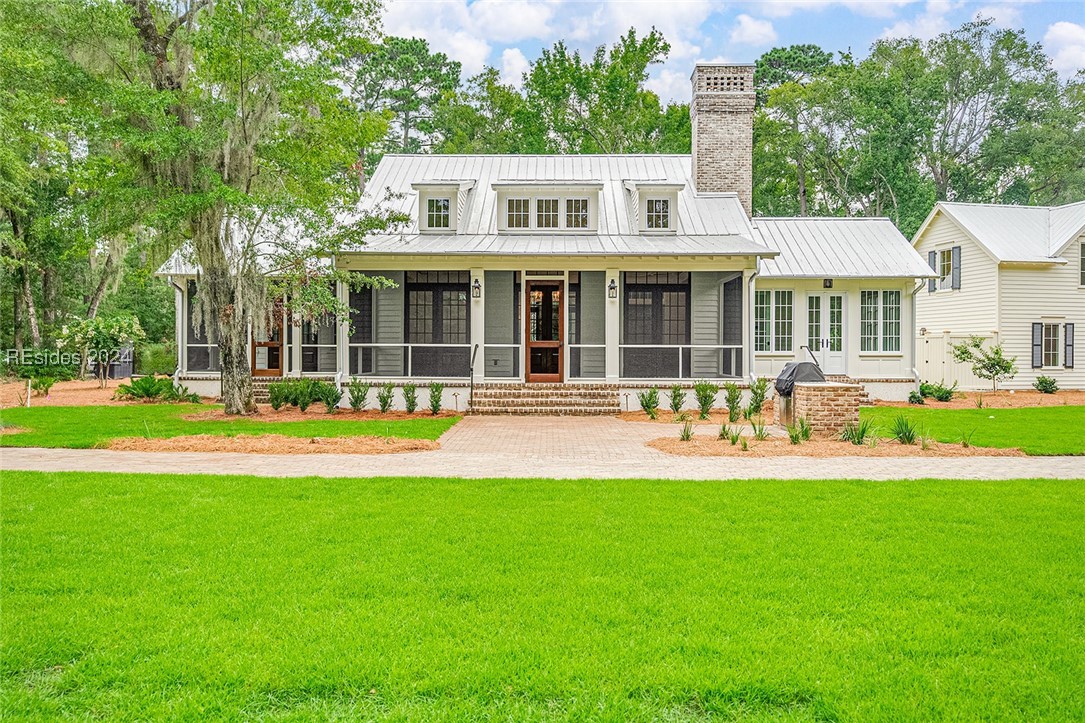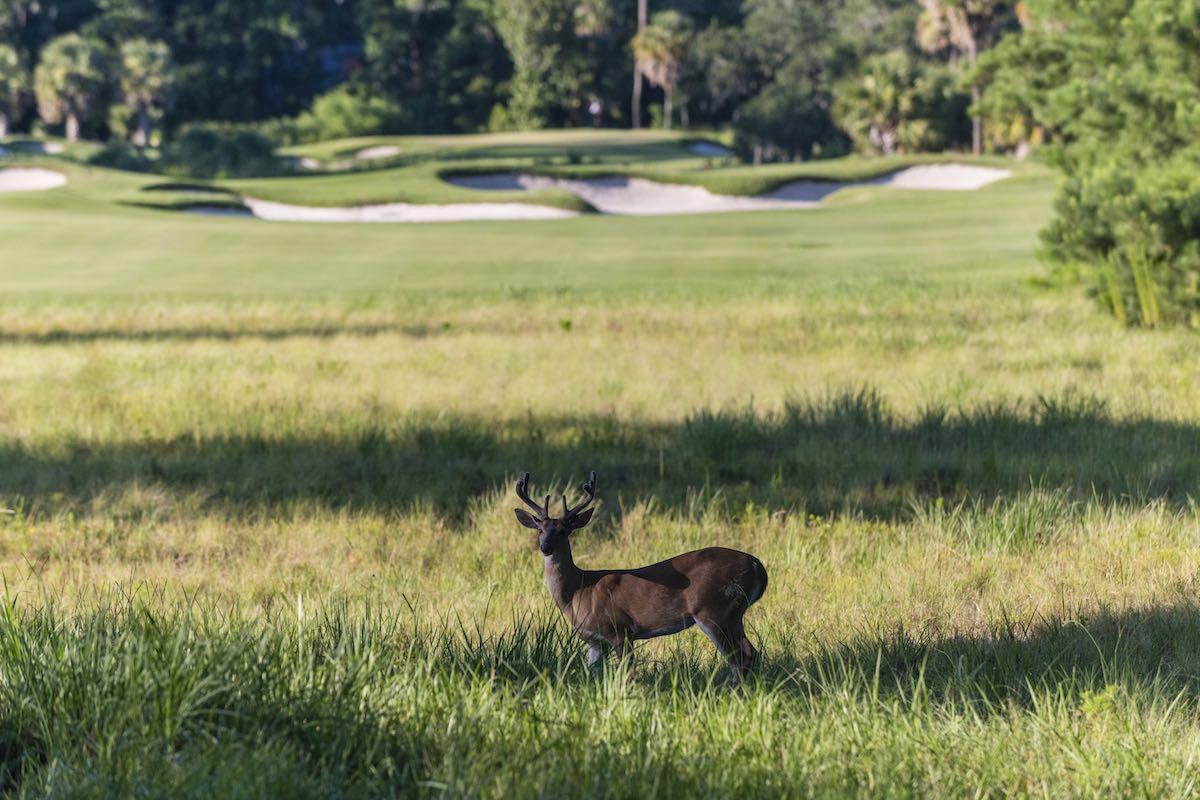Palmetto Bluff Real Estate Company Sales Office
Office Hours
Monday-Friday 9am - 5pm
Saturday 9am - 4pm
Sunday 12 - 4pm
Saturday 9am - 4pm
Sunday 12 - 4pm
With the opening of Moreland Village and the Conservancy’s move to its new offices and outdoor lecture classrooms, these are exciting times here on the Bluff. The commitment of the Palmetto Bluff Conservancy to this land is as strong as it’s ever been. We take our responsibility to this property and all who inhabit it very seriously, and we make it our life’s work to be good environmental stewards of the Bluff to ensure it is preserved for years to come.
With this in mind, you can imagine my thrill when Crescent Communities decided to donate 90 acres of land to the managed forest of Palmetto Bluff.
The managed forest is made up of several different natural habitats, some of which are environmentally sensitive and species-rich. The transitions leading into the lower areas of the land are a mix of maritime forest and upland pine hardwood habitat types. The maritime forest edge is made up of predominantly live oak over-story with a mix of southern magnolias, several different red oak tree species, and the fragrant eastern red cedar. The understory is a mix of wax myrtle and yaupon holly trees, both of which provide a fresh punch of greenery throughout the seasons.
The upland pine mixed hardwood areas on the perimeter of the managed forest consist of old loblolly pines with a slash pine in the lower reaches of the transitional zones. Southern red oaks, laurel oaks and water oaks are intermingled with these pine species. Within the true wetland bottom you can find beautiful red maples, black gums, sweet gums and several red oak species of water oak and laurel oak. Blue stem palmetto trees dot this landscape and become the predominant over-story tree in the old abandoned rice fields within this area. These storied rice fields look prehistoric with the abundance of large palms intertwined with live oaks and ancient muscadine grape vines throughout the forest’s canopy.
The wildlife in these habitats is plentiful, to say the least. Raccoons and opossums can be found foraging in and out of all of the habitats within the managed forest. The white-tailed deer is a permanent resident of this environment, making a cozy home in all of the natural habitat types on the land. The eastern wild turkey frequents the transitional edges of the forest, scratching and foraging for protein such as grasshoppers and beetles. Many different species of birds can be found throughout: from our visiting neotropical migratory songbirds to an array of wading birds like the white ibis and great blue heron. Mink is also a resident along the marsh edges of the managed forest.
Not only is there amazing beauty within this piece of land, there is also historic significance as well. Remnants of old rice fields can be found within the forest as well as intact dike systems that bordered these rice fields.
One day very soon boardwalks will cross the River Road Preserve, providing the Conservancy with an outdoor classroom unlike any other. Lectures exploring the flora and fauna of this remarkable landscape as well as historic features will be weekly events. The dedication of this beautiful land is just another step in Palmetto Bluff’s commitment to be good stewards of the land and to preserve precious habitats and green space for our current and future inhabitants.
Learn about the preserves of the Bluff.
RIVER ROAD PRESERVE
To walk the trails in the River Road Preserve is to take a step back in time. The maritime forest edge, with its draping live oaks, majestic southern red oaks, water oaks and loblolly pines, hosts many of Palmetto Bluff’s animal species. The white-tailed deer feed alongside furbearers such as the raccoon and opossum that frequent the edge. The wax myrtle and cedar mid-story make an excellent nesting habitat for the painted bunting. The southern magnolia is found throughout this habitat, scenting the forest with an amazing perfume from its massive white blossoms.
The upland pine hardwood stands found in the River Road Preserve have an over-story of predominantly loblolly pine trees with slash pine trees in the lower transitions. The oak species found here are southern red oak, water oak, white oak and live oak. This habitat is great for viewing the eastern wild turkey foraging for protein on the forest floor. This more open woodland area has a host of raptors that also call it home, too. At night, the great horned owl and barred owl make their presence known to other owls by their calls between pairs as they hunt silently through the landscape. The haunting call of the screech owl can be heard on any night in the Preserve, and these owls live in all the other habitats of the Bluff as well.
Among all of the habitats, the evergreen wetlands within the Preserve are home to the most concentrated number of species. Fresh water is the reason that this area is so species-rich, and most animal species visit this area daily, but some animals do make it their permanent home. Salamanders and amphiumas (aquatic salamanders) frequent the fishless wetlands, and the wood duck lays her eggs in the cavities of the oaks that are found in this habitat. She will then raise her young in these shallow water areas until they can fend for themselves.
The over-story trees that make up this habitat are slash pine, sweetgum and sweet bay magnolia, red maple, loblolly bay and an occasional live oak. The mid-story consists of sparkleberry, wax myrtle, red bay and swamp bay trees. The under-story is made up of river cane, blueberry bushes and saw palmetto trees. Any of the animal species can be seen in the Preserve on quiet walks all throughout the day. Pay close attention, and River Road Preserve will come alive.
SANDHILL LOOP TRAIL
The Sandhill Loop Trail is located off the longer walking trail on Old Palmetto Bluff Road between the eastern gate of the May River Forest neighborhood in Palmetto Bluff and the fifth hole on the May River Golf Course. This trail is unique because of the habitat it protects: a true sandhill habitat. Found on the top of an ancient dune system from the prehistoric era when the ocean receded from Palmetto Bluff, this amazing natural environment can only be found in one other area on the property.
Within this habitat the over-story trees consist of sand live oak, post oak and turkey oak. The sand live oak, a miniature of the majestic live oak, is a true live oak, but will not grow larger than its current height, never reaching the size of the live oaks found elsewhere on the property. The post oak is in the white oak family and is only found on the highest sand hills. Its shaggy bark resembles the white oak (quercus alba), but the leaf is completely different. The turkey oak is in the red oak family, and although the leaves look similar to the southern red oak, they are two different species. The turkey oak doesn’t grow as large as other red oak species and is found only on the highest sandy sites.
The mid-story of this unique habitat consists of a plant species that is threatened throughout its range here in South Carolina. Rusty lyonia grows in abundance within this habitat type and can actually be found in other areas on Palmetto Bluff too. Thanks to our land management techniques, this species, although threatened in much of the state, grows in abundance here. Along with this species you can also find the highbush blueberry and saw palmetto trees, as well as yaupon holly and sparkleberry trees throughout this trail system. The aromatic sassafras tree and witch hazel, both with healing powers, can be found in this environment.
Many animal species call this preserved area home, such as the white-tailed deer and the eastern wild turkey along with many species of songbirds. Bobcats and the grey fox can be found here chasing after their prey. To see this wildlife in action, it is best to hit this trail at daylight or right at dark.
HEADWATERS TRAIL
The Headwaters trail system is located at the west entry to the Headwaters neighborhood in Palmetto Bluff, meandering by the banks of Lake Haynes and eventually ending under an osprey nest. The nest is larger than normal for ospreys and is in the top of an ancient longleaf pine.
If visitors hike or even bike this trail during the early morning hours, they will see a bounty of wildlife, from neotropical migratory songbirds in the spring to the eastern wild turkey and white-tailed deer in the fall. Many raccoons and opossums call this trail system home, and Lake Haynes is teeming with largemouth bass and bluegill that can be fished only from the trail bank.
There are several different natural habitat types found along the Headwaters Trail, such as the longleaf pine habitat, which is close to the osprey nest on the eastern side of the trail. This is a very small habitat type, spanning just a bit under an acre. Within this habitat one will find an over-story of longleaf pine trees with a mixture of gallberry and wax myrtle trees as the predominant under-story species. Highbush blueberries can be found in this habitat and can make for a great snack during the early summer months.
Mature pine mixed hardwood upland is another habitat type found along the trail. The predominant over-story consists of loblolly and slash pines with an under-story of wax myrtle and saw palmetto trees, and an overabundance of highbush blueberry and dwarf shiny blueberry bushes. The mid-story in this habitat type is predominantly sparkleberry and sweetleaf trees. The evergreen wetlands found within this trail system are beautiful and species-rich. The over-story tree species within these wetland areas consist of southern magnolia on the transitions with loblolly bay and red maple in the lowest regions. The under-story consists of river cane and fetterbush, which forms impenetrable thickets that most animals utilize for escape cover. Under-story species found in this habitat are Virginia sweetspire, dog hobble and gallberry, along with an array of fern species, making these areas resemble a scene from a prehistoric era.
This trail system has placards that teach hikers about the flora along the way. One can learn not only the biology of any given species, but also fun facts such as what the species is used for and if it is edible. This is a great place to spend an hour or two walking with the family or alone to collect one’s thoughts and get back to the nature that is Palmetto Bluff.
Photos by Allen Kennedy

Tis’ the season for wrapping, and we have plenty of gifts to share from 2024! This year was filled with exciting new beginnings and continued growth at Palmetto Bluff. From two new golf courses to awards for both Montage Palmetto Bluff and FLOW...

Photos courtesy of Leah Bailey DesignPhoto credit: Kelli Boyd PhotographyAs the holiday season descends upon the Lowcountry, Palmetto Bluff becomes a festive haven, where classic Southern architecture meets personal style. Whether you prefer timeless elegance ...

Executive Chef Beth Cosgrove and Registered Dietician Lindsay Ford recently led a Healthy Cooking Demonstration for residents interested in cooking healthy, delicious food to promote wellness. Attendees left with new recipes and flavors to try at home. The But...

Photographs by Anne CaufmannStory by Barry Kaufman The story of this house begins with another.Mike and Melissa Pereyo first visited Palmetto Bluff in 2010 to visit longtime friends Butch and Debbie Floyd. The Floyds built their home here when the fringes of t...

How to Spend a Lowcountry Christmas at Palmetto Bluff There's no better way to start anticipating the holidays than by making plans to spend time with family and friends. Now that the holiday season has arrived, many look forward to embracing the Christmas sp...

Explore 130 August Lane at Montage Residences Nestled in the heart of the Lowcountry, the Montage Residences at Palmetto Bluff offer an unparalleled blend of elegance, exclusivity, and Southern charm. This private collection of homes sits amidst the lush land...

Experience Winter Wildlife This Season at Palmetto Bluff The Lowcountry is a wondrous place to live, not only for its breathtaking scenery and historical significance but also for the wildlife that inhabits it. Winter wildlife in South Carolina includes a wid...

As summer’s heavy air fades into fall’s cool breezes, our resident wildlife are busy preparing for another Lowcountry winter.In the fall, eastern wild turkeys move into habitats mostly dominated by hardwood trees such as oaks, hickories, beeches, cypresses, tu...

The Arts Initiative at Palmetto Bluff hosted an unforgettable evening in the May River Chapel this past October with our visiting Artist in Residence, multi-Grammy-winning singer-songwriter Clay Ross, founding member of the Billboard chart-topping band Ranky T...

This year’s FLOW FEST was an unforgettable celebration of art, music, and community spirit. Held on a stunning autumn afternoon by the May River, our third annual arts and music festival, hosted by The Arts Initiative at Palmetto Bluff, brought together friend...
Learn about the Palmetto Bluff Conservancy and how we keep the vision of our land in place.
On land or water, there is an ever-evolving variety of activities.
We do not attempt to independently verify the currency, completeness, accuracy or authenticity of the data contained herein. All area measurements and calculations are approximate and should be independently verified. Data may be subject to transcription and transmission errors. Accordingly, the data is provided on an “as is” “as available” basis only and may not reflect all real estate activity in the market”. © [2023] REsides, Inc. All rights reserved. Certain information contained herein is derived from information, which is the licensed property of, and copyrighted by, REsides, Inc.